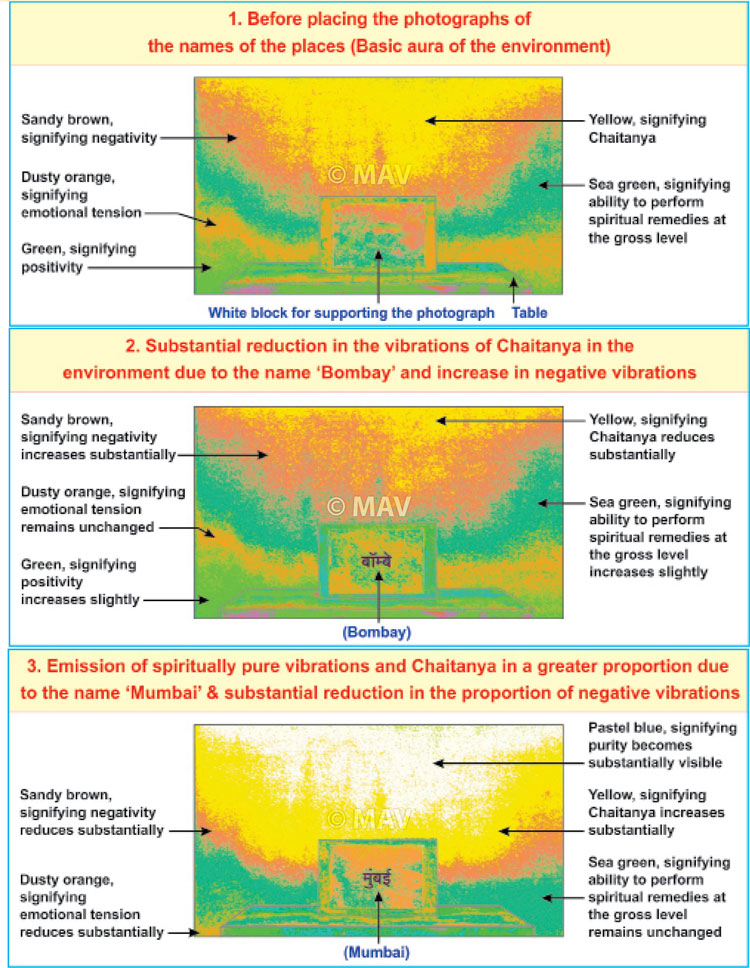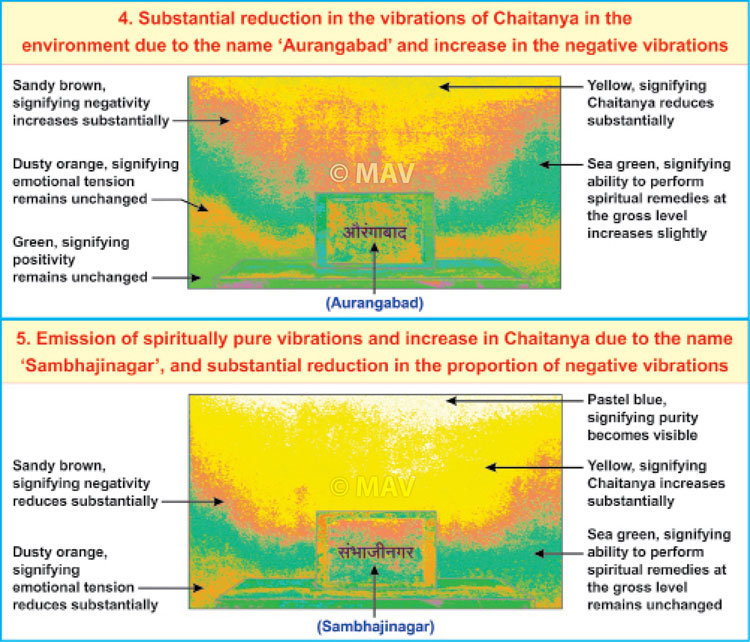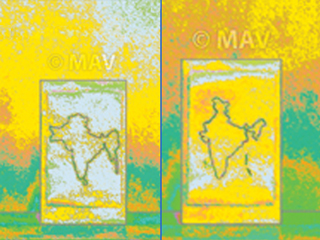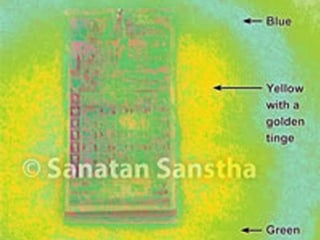Scientific experiment conducted by Maharshi Adhyatma
Vishwavidyalay using ‘PIP’ (Polycontrast Interference Photography) technology
In the ancient times, the names of the cities were based on the names of the local Gramadevata (Village Deity), brave kings, etc. As a result, the names of the cities were sattvik (Spiritually pure). With time, foreigners started attacking India. Consequently, Islamic reign began in some parts of the country. The Islamic rulers changed the Hindu names of towns and cities under their control and made Islamic names prevalent.
With time, the British came to India under the pretext of trading. They targeted many princely States and seized control over them. Within some years, entire India came under the British rule. The British thrust their language and immoral culture on the people of India. Similarly, they named the main streets of the cities, towns, railway stations, etc. after British kings, queens, etc.
It has been 70 years since India became independent. It is India’s misfortune that in all these years, Indian politicians could not change the Islamic or English names of the cities, main streets of the cities, towns, railway stations, etc.
After the BJP came to power, the names of only 1-2 streets have been changed. Some weeks ago, when Yogi Adityanath, the Chief Minister of Uttar Pradesh, announced that Faizabad will be renamed Ayodhya, religious fanatics and so-called secularists started objecting and criticising to the renaming.
The name Aurangabad of the city in Maharashtra is based on the Mughal emperor Aurangzeb. Proud Hindus address this city as Sambhajinagar.
During the British rule, Mumbai was renamed Bombay, which was prevalent till 1995. After this the city regained its original name Mumbai. ‘Mumbai’ is derived from Deity Mumbadevi, which is the Sthanadevata (The presiding Deity of a place is called ‘Sthanadevata’) of Mumbai.
On 23.2.2016, an experiment was conducted by Maharshi Adhyatma Vishwavidyalay at Sanatan Sanstha’s Ramnathi Ashram, Goa using PIP (Polycontrast Interference Photography) technology to scientifically study the impact of vibrations emitting from the names of the cities on the environment.
PIP technology is useful in studying the energy field (Aura) around objects and people. The observations of this experiment and related analysis are given in this article.
These PIP photos indicate that due to non-sattvik names such as Bombay and Aurangabad, the proportion of the vibrations of Chaitanya in the environment reduced greatly; however, due to the sattvik names such as Mumbai and Sambhajinagar, the vibrations of purity were emitted into the environment, and the proportion of the vibrations of Chaitanya increased significantly.
Note 1 : While comparing PIP photos number 2, 3, 4 and 5 with the Baseline aura (PIP photo number 1), the colours of the area specifically covered by the photocopies, block and table have not been taken into consideration since the PIP technology primarily measures the energy field (Aura) around an object or a person.
Note 2 : In a PIP photo, if light green or pastel blue that represent superior level positive vibrations are seen, the proportion of yellow, dark green or green that represent moderate level positive vibrations reduce or these colours completely vanish. This is considered to be a good sign; because, then, the moderate level vibrations have been replaced by superior level vibrations.
1. Nature of the experiment
In this experiment, a white wooden block was placed on the table to support the photocopies of the names of the cities to be used in the experiment, and a photo of the environment was clicked using PIP technology.
This is called the ‘Baseline reading’ of the environment. Then, one-by-one, PIP photos of the photocopies of the names Bombay, Mumbai, Aurangabad and Sambhajinagar were clicked after placing them on the table. A comparative study of the area surrounding these photocopies helped us understand the impact of vibrations emitting from these names on the environment.
Note for readers : Due to shortage of space we have given the common features of PIP article on goo.gl/TwBxhe(Please note that some letters are in Caps) – PIP technology has the facility of displaying positive and negative vibrations of objects through colours, precautions taken during the experiment, information about the colours seen in the aura etc.
2. Observations and their analysis


2A. Baseline reading : In the aura of the Baseline reading (Meaning, in the aura of the environment clicked before setting the samples of the experiment on the table) the total negative vibrations were 45% and total positive vibrations were 55%.
In the readings given ahead, the auras of the samples used in the experiment have been compared with the aura of the Baseline reading.
2B. Due to the name ‘Bombay’, the proportion of positive vibrations and the vibrations of Chaitanya (Divine consciousness) in the environment reducing greatly and the proportion of negative vibrations increasing : In the aura of the name ‘Bombay’, the total negative vibrations were 53% and the total positive vibrations were 47%. This means because of this name the positive vibrations in the environment had reduced by 8% when compared with the Baseline reading. In the aura of this name, the yellow of Chaitanya was 15%, which means it had reduced by half when compared with the yellow of Chaitanya (31%) in the Baseline reading. From these observations it becomes clear that due to the name ‘Bombay’, the proportion of the positive vibrations and the vibrations of Chaitanya in the environment greatly reduced and proportion of negative vibrations increased.
2C. The name ‘Mumbai’ emitting higher proportion of vibrations of purity into the environment, the proportion of vibrations of Chaitanya increasing significantly and the proportion of negative vibrations reducing significantly : Aspects mentioned ahead that indicate an increase in positive vibrations pertaining to the aura of the name ‘Mumbai’ were understood.
1. The aura of the name ‘Mumbai’ showed a total of 89% positive and 11% negative vibrations. This means the positive vibrations in the aura of the name ‘Mumbai’ were higher by 34% when compared with the Baseline reading.
2. The yellow of Chaitanya was 45%, which means it was significantly higher than that of the yellow of Chaitanya (31%) in the Baseline reading.
3. In the aura, pastel blue which indicates the presence of higher level positive vibrations (of purity and sanctity) than the yellow of Chaitanya was visible to the extent of 28%.
In short, we understood that due to the name ‘Mumbai’, the proportion of Chaitanya in the environment increased significantly and the proportion of negative vibrations reduced significantly.
2D. Due to the name ‘Aurangabad’, the proportion of the vibrations of Chaitanya reducing significantly and the proportion of negative vibrations increasing significantly : The aura of the name ‘Aurangabad’ showed a total of 52% negative vibrations and 48% positive vibrations. This means that due to this name, the total positive vibrations in the environment reduced by 7% when compared with the Baseline reading. In the aura of this name the yellow of Chaitanya was 19%, which means it reduced significantly than that of the yellow of Chaitanya (31%) in the Baseline reading. From these observations we understood that due to the name ‘Aurangabad’, the proportion of positive vibrations and the proportion of Chaitanya in the environment reduced significantly and the proportion of negative vibrations increased significantly.
2E. Due to the name ‘Sambhajinagar’, vibrations of purity getting emitted into the environment, proportion of the vibrations of Chaitanya increasing significantly and proportion of negative vibrations reducing significantly :
Aspects mentioned ahead that indicate an increase in positive vibrations pertaining to the aura of the name ‘Sambhajinagar’ were understood.
1. The aura of the name ‘Sambhajinagar’ showed a total of 85% positive vibrations and 15% negative vibrations. This means the positive vibrations in the aura of the name ‘Sambhajinagar’ were higher by 30% when compared with the Baseline reading.
2. The yellow of Chaitanya was 58%, which means it was significantly more than the yellow of Chaitanya (31%) in the Baseline reading.
3. In the aura, when compared with the yellow of Chaitanya, pastel blue which indicates the presence of higher-level positive vibrations (of purity and sanctity) was visible to the extent of 9%.
In short, we understood that due to the name ‘Sambhajinagar’, the vibrations of purity emitted into the environment, the proportion of Chaitanya in the environment increased significantly and the proportion of negative vibrations reduced significantly.
The spiritual analysis of the above observations is given in ‘Point 3’.
3. Spiritual analysis of the observations
3A. The reason for the names Aurangabad and Bombay being non-sattvik; the name Sambhajinagar being sattvik and the name Mumbai being even more sattvik : As per a law in Spirituality, ‘Word, touch, form, taste, fragrance and their energies co-exist’. Accordingly, where there is form (For example, the name of an object), corresponding energy (Vibrations) also exist. The aspects based on this theory are given ahead.
1. Aurangzeb was a cruel and pitiless ruler. Due to the high proportion of Tama component in him, his personality was Tama-predominant. A person with significant amount of Tama component has significant amount of negative vibrations. Hence, the name Aurangabad, which is derived from the name Aurangzeb, emitted high amount of negative vibrations into the environment.
2. Dharmaveer Sambhajiraje was a king who abided by Dharma and took care of his subjects. Proportion of Sattva component in him was higher and therefore, he was sattvik. The predominance of the Sattva component in an individual leads to significant amount of positive vibrations in him.
Dharmaveer Sambhajiraje fought very hard to protect Hindu Dharma and his people from the evil Aurangzeb. He suffered greatly after being captured by the enemy; but he refused to convert to another religion till the very end. He sacrificed his life for the protection of Dharma. Inspired by his ultimate sacrifice, thousands of mavalas (Brave Maratha warriors) got ready to fight against Aurangzeb to protect Dharma.
‘Sambhajinagar’ is derived from the courageous and heroic Sambhajiraje who was Sattva-predominant, a devout follower of Dharma and brave; therefore, this name emitted higher amount of positive vibrations into the environment.
3. The name of Mumbai city is based on the Sthanadevata, Mumbadevi. This Deity is the protector of Mumbai. Deities possess high level of Chaitanya. The Name of a Deity attracts the corresponding Divine vibrations. In the ancient days, the names of cities were based on the names of Deities so as to receive their continuous grace and for protection of the residents of the city from all calamities. From this we understood that the name Mumbai has a spiritual foundation.
4. The name Mumbai has a spiritual foundation; however, so is not the case with the name Bombay. The British were very shrewd and selfish. They fraudulently took control of many princely States in India. They imposed their spiritually impure language, conduct, diet and immoral culture on Indians. They changed the name of Mumbai to Bombay. A sattvik language contains high amount of positive vibrations; whereas, a non-sattvik language contains high amount of negative vibrations. Sanskrut followed by Marathi are very sattvik languages. In contrast, since English is not a sattvik language, negative vibrations get emitted into the environment from the name Bombay.
In short, due to the non-sattvik names of cities such as Aurangabad and Bombay, the residents of these cities suffer from negative, meaning, distressing energies. Hence, it is preferable to re-name the cities with the names based on Deities, sattvik Hindu kings, etc. In so doing, the pride in and respect for the language, Nation & Dharma will be preserved. In the forthcoming ‘Hindu Nation’ every town, city, District, etc. will have sattvik names !
– Mrs. Madhura Dhananjay Karve, Maharshi Adhyatma Vishwavidyalay, Goa. (19.1.2017)
E-mail : mav.research2014@gmail.com

 Effect of the map of ‘Akhand Bharat’ and the map of contemporary Bharat on the...
Effect of the map of ‘Akhand Bharat’ and the map of contemporary Bharat on the... Effects on the environment of a pot emitting fragrance
Effects on the environment of a pot emitting fragrance Spiritual Puzzle
Spiritual Puzzle Spiritual importance of ‘Sanatan Almanac’
Spiritual importance of ‘Sanatan Almanac’